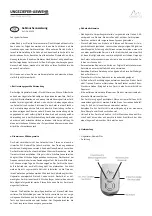
Diagnosing Fiber Cabling Faults
Diagnosing OTDR Test Failures
10-7
10
Table 10-3.
•
A dirty, scratched, cracked, misaligned, or unseated connector. Misaligned or unseated
connectors can also cause large reflections that produce ghosts. Bad connectors should be
cleaned, repolished, or replaced.
•
A good connector with a sharp bend or crack within its deadzone. If the cable is tightly bent
the tester may indicate a break, especially at longer wavelengths or in Manual OTDR mode
with smaller resolution settings. Use a visual fault locator to precisely locate the fault.
•
A crack in the fiber. Use a visual fault locator to precisely locate the fault.
•
A connection between mismatched fibers (different backscatter coefficients, core sizes,
numerical apertures, or other parameters). The top example could be caused by a larger core
(on the left) connected to a smaller core.
Diagnosing OTDR Test Failures (cont.)
-continued-
amd160.eps
Large reflective event with high loss (top) or excessive tailing (bottom). May be identified as an
end event though it occurs before the end of the cabling. May be caused by the following:
Summary of Contents for DTX-1800
Page 4: ......
Page 18: ...DTX Series CableAnalyzer Technical Reference Handbook xiv ...
Page 132: ...DTX Series CableAnalyzer Technical Reference Handbook 4 8 ...
Page 158: ...DTX Series CableAnalyzer Technical Reference Handbook 6 14 ...
Page 270: ...DTX Series CableAnalyzer Technical Reference Handbook 8 62 ...
Page 284: ...DTX Series CableAnalyzer Technical Reference Handbook 10 10 ...
Page 304: ...DTX Series CableAnalyzer Technical Reference Handbook 11 20 ...
Page 372: ...DTX Series CableAnalyzer Technical Reference Handbook A 8 ...
Page 374: ...DTX Series CableAnalyzer Technical Reference Handbook B 2 ...















































